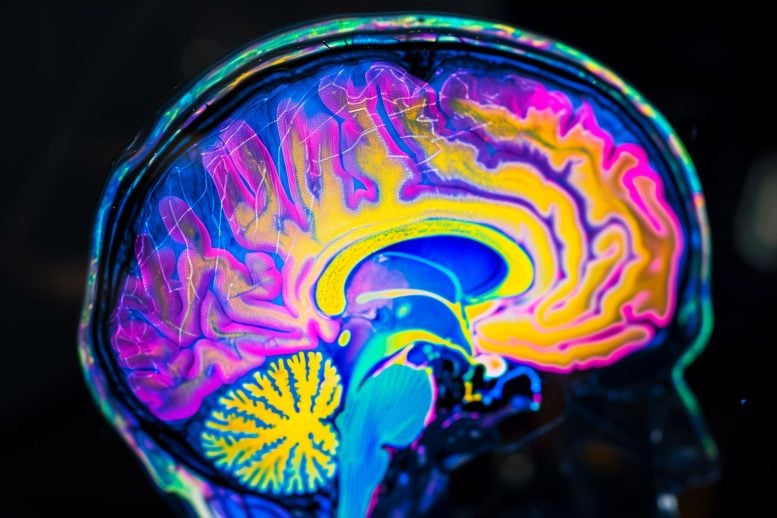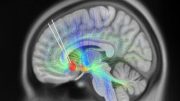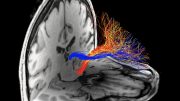
Innovative research uncovers the diverse brain changes associated with mental illnesses by analyzing over 1,000 brain regions in individuals, offering new insights into personalized treatment targets. Credit: SciTechDaily.com
Mapping brain changes in nearly 1,300 people with different types of mental illness reveals diversity across conditions.
A breakthrough project mapping brain changes in nearly 1,300 people diagnosed with six different types of mental illness has revealed the extraordinary diversity of brain changes found in people with conditions like major depression and schizophrenia.
The study, published in Nature Neuroscience and led by researchers at Monash University’s Turner Institute for Brain and Mental Health and School of Psychological Sciences, used brain imaging to measure the size, or volume, of over 1000 different brain regions.
Innovative Statistical Methods Reveal Individual Differences
“Over the past few decades, researchers have mapped brain areas showing reduced volume in people diagnosed with a wide variety of mental illness, but this work has largely focused on group averages, which makes it difficult to understand what is happening in the brains of individual people,” said PhD student Ms. Ashlea Segal, who led the research. “For example, knowing that the average height of the Australian population is about 1.7 m tells me very little about the height of my next-door neighbor,” she added.
The team used new statistical techniques developed by Prof Andre Marquand at the Donders Institute, Netherlands, who co-led the project, to map regions in the brain showing unusually small or large volumes in people diagnosed with either schizophrenia, depression, bipolar disorder, obsessive-compulsive disorder, attention-deficit hyperactivity disorder, or autism spectrum disorder.
“We used a statistical model to establish expectations about brain size given someone’s age and sex. We can then quantify how much an individual person’s brain volume deviates from these expectations, much like the growth charts commonly used for height and weight in pediatrics,” said Professor Alex Fornito, who led the research team.
“We confirmed earlier findings that the specific brain regions showing large deviations in brain volume vary a lot across individuals, with no more than 7% of people with the same diagnosis showing a major deviation in the same brain area,” said Professor Fornito. “This result means that it is difficult to pinpoint treatment targets or causal mechanisms by focusing on group averages alone. It may also explain why people with the same diagnosis show wide variability in their symptom profiles and treatment outcomes” he added.
Uncovering Connectivity and Potential Treatment Targets
The team then investigated the connectivity of the areas showing large volume deviations. “Because the brain is a network, dysfunction in one area can spread to affect other, connected sites. We found that, while deviations occurred in distinct brain regions across different people, they were often connected to common upstream or downstream areas, meaning they aggregated within the same brain circuits” said Ms. Segal. “It’s possible that this circuit-level overlap explains commonalities between people with the same diagnosis, such as, for example, why two people with schizophrenia generally have more symptoms in common than a person with schizophrenia and one with depression”.
The team leveraged their new approach to identify potential treatment targets for different disorders. “We found that certain specific brain circuits were preferentially involved in some disorders, suggesting that they are potential treatment targets” explained Ms. Segal. “However, our findings suggest that these targets will only be appropriate for a subset of people. For instance, we found evidence that brain circuits linked to frontal areas were preferentially involved in depression. These circuits are commonly used as targets for non-invasive brain stimulation therapies, but our data suggest that they may only be effective targets for around 1/3 of people.”
The approach developed by the team opens new opportunities for mapping brain changes in mental illness. “The framework we have developed allows us to understand the diversity of brain changes in people with mental illness at different levels, from individual regions through to more widespread brain circuits and networks, offering a deeper insight into how the brain is affected in individual people,” said Professor Fornito.
Reference: “Regional, circuit and network heterogeneity of brain abnormalities in psychiatric disorders” by Ashlea Segal, Linden Parkes, Kevin Aquino, Seyed Mostafa Kia, Thomas Wolfers, Barbara Franke, Martine Hoogman, Christian F. Beckmann, Lars T. Westlye, Ole A. Andreassen, Andrew Zalesky, Ben J. Harrison, Christopher G. Davey, Carles Soriano-Mas, Narcís Cardoner, Jeggan Tiego, Murat Yücel, Leah Braganza, Chao Suo, Michael Berk, Sue Cotton, Mark A. Bellgrove, Andre F. Marquand and Alex Fornito, 14 August 2023, Nature Neuroscience.
DOI: 10.1038/s41593-023-01404-6









While it practically boggles my mind that there can even be more than a thousand disparate regions of the brain, with a family history of food allergies and dementia and a personal history of two disparate incidents of temporary short-term memory problems, I feel obligated to share again what I’ve been sharing with thousands of professional others of more authority, qualification and/or resources of my personal lay findings on mental disorders (albeit, generally, in-vain): the very, very mild reactions of my (Dr. Arthur F. Coca’s, by 1935) kind of food allergies cause inflammation which leads to acidic blood (e.g., uric acid, minimally) which can damage the myelin sheaths of nerve cells any area it flows through. Prior reports on FMRI imaging of the brain suggest to me it is the most active part of the brain (minimally) which will be most affected. With multiple epidemics of mental disorders in recent years, I believe addressing the allergies and the acidic blood would be most productive.